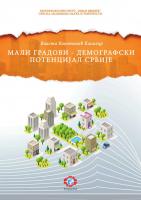
Small cities – Demographic potential of Serbia
Book 90
ISBN 978-86-80029-69-6
UDK 711.435:314(497.11)
Year of publishing: 2016
Authors: Vlasta Kokotović Kanazir
Editor: Željko Bjeljac
The monograph “The demographic potential of small towns in Serbia” is based on the well-known fact about the uneven and differentiated demographic development of Serbia, which represents one of the fundamental principles of a policy of polycentric development of Serbia and its emphasis as a strategic imperative in the Spatial Development Strategy of the Republic of Serbia (2009). That is why the question of development and the potential of small towns in Serbia is extremely important which implies research of demographic resources and demographic potential, as same as estimation of future demographic trends and population movements in them. Accordingly, the main goal of the monograph is to provide insight into the demographic “state” of urban areas in Serbia, through identification of towns up to 20,000 inhabitants and analysis of demographic indicators, such as population dynamics and population changes, vital parameters, age-sex structure characteristics and migration characteristics. Analytical segment of the monograph includes basic demographic and functional indicators of development, as well as changes in the development of urban settlements. Reached level in demographic development can be shown through identification of changes that have occurred in the redistribution of the population in the settlements, primarily through share of the population inhabited in small urban areas, as indicators of the concentration degree achieved in the given areas.
In recent decades, the Republic of Serbia is characterized by prominent demographic regression. In the last inter-census period (2002-2011.),population development in Serbia recorded extremely unfavorable tendencies, which are reflected in the deepening of the three demographic processes: (1) total depopulation (population decline); (2) natural depopulation (number of deaths exceeds the number of live births), and (3) demographic aging. These processes are particularly noticeable at the settlement level. Since the late 20thcentury, population development of the studied settlements can be classified into several groups according to population dynamics. Among the small towns only a few isolated centers in the Western (Arilje, Bajina Bašta, Kosjerić, Ivanjica, Mali Zvornik) and Central Serbia (Topola, Gornji Milanovac, Subotica) have relatively more dynamic growth. Also, the specific situation is in Vojvodina, where a large number of small towns recorded depopulation for many years. These are the towns of eastern Vojvodina, in contrast to the western regions, where the influx of refugees from the former Yugoslavia contributed to the demographic growth of these urban centers.Small towns are not a unified group and is quite difficult to perform universal
conclusions. There are great differences among the towns which development
category is similar to medium-sized towns and urban settlements that are not municipal centers, as well as among towns which have monofunctional economy
(mining settlements, spa resorts, etc.) and towns with balanced economy development. Several common characteristics of small towns are: this group of settlements have less than 20,000 inhabitants according to 2011 Census and character of urban settlements by statistical and legal criteria; they have a function and importance of the municipal center or supplementary municipal center;
they are in direct contact with the rural environment; and as the most important
characteristic is the role of small towns as the centers of urbanization in rural areas. The role of a small town as a municipal, administrative, economic, cultural and educational center is reflected primarily through establishing appropriate strategies and policy for development at the municipal level. In the future, small towns could be the main driver of demographic revitalization of Serbia. For demographic development is essential to establish appropriate and applicable population policy at the local level in order to utilization of existing human resources.







